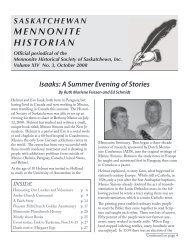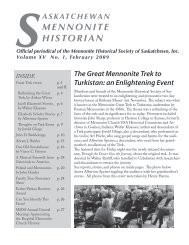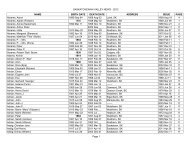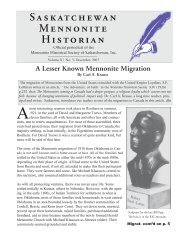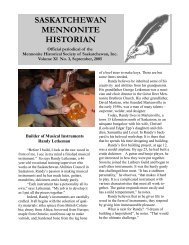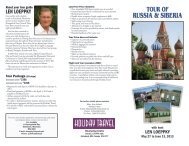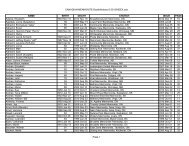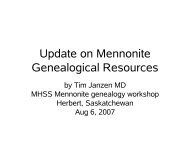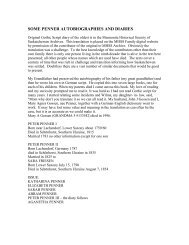DNA testing applications for Mennonite Genealogists
DNA testing applications for Mennonite Genealogists
DNA testing applications for Mennonite Genealogists
You also want an ePaper? Increase the reach of your titles
YUMPU automatically turns print PDFs into web optimized ePapers that Google loves.
Genetic Genealogy: A New<br />
Tool <strong>for</strong> <strong>Mennonite</strong><br />
<strong>Genealogists</strong><br />
by Tim Janzen MD<br />
Portland, Oregon<br />
tjanzen@comcast.net<br />
503-761-8781<br />
MHSS <strong>Mennonite</strong> Genealogy Workshop<br />
Herbert, Saskatchewan<br />
August 4, 2007
Historical background<br />
• <strong>DNA</strong> structure described by James Watson and<br />
Francis Crick in 1953<br />
• First worldwide study of mitochondrial <strong>DNA</strong><br />
published by Rebecca Cann in 1987<br />
• Detailed worldwide study of Y chromosome <strong>DNA</strong><br />
published in 2000 by Peter Underhill<br />
• Commercial <strong>DNA</strong> <strong>testing</strong> <strong>for</strong> genealogists<br />
became available in 2000<br />
• Human Genome Project completed in 2003
Biological Background<br />
• Humans have 46 chromosomes; of these 44 are<br />
autosomal chromosomes and 2 are sex<br />
chromosomes<br />
• About 3.2 billion base pairs in the human<br />
genome, of which 95-98% don’t code <strong>for</strong><br />
anything<br />
• 99.9% of human autosomal <strong>DNA</strong> is identical<br />
• Mitochondrial <strong>DNA</strong> has 16,569 base pairs, of<br />
which 1449 base pairs don’t code <strong>for</strong> anything
The four nucleotides (bases)<br />
• Adenine (A)<br />
• Cytosine (C)<br />
• Guanine (G)<br />
• Thymine (T)<br />
• Adenine pairs with Thymine<br />
• Cytosine pairs with Guanine
Major Types of <strong>DNA</strong><br />
• Y chromosome: found only in males and<br />
passed from father to son; only 26 million base<br />
pairs sequenced thus far out of about 60 million<br />
• Mitochondrial <strong>DNA</strong>: found in both males and<br />
females, but passed on only by the mother to<br />
her children; 16,569 base pairs in a circle<br />
• Autosomal <strong>DNA</strong>: 44 chromosomes; each parent<br />
contributes one half of the <strong>DNA</strong> to their children<br />
• X chromosome: 2 in females and 1 in males;<br />
sons receive one chromosome from their mother<br />
and daughters receive one chromosome from<br />
each parent
Common Terms in <strong>DNA</strong> research<br />
• Marker: an identifiable locus (location) on<br />
a chromosome<br />
• Haplotype: a set of values <strong>for</strong> a group of<br />
genetic markers that is inherited as a unit<br />
• Haplogroup: a group of similar patterned<br />
and related haplotypes that share a<br />
common ancestor due to a specific<br />
mutation
More <strong>DNA</strong> terms<br />
• Single Nucleotide Polymorphism (SNP):<br />
common variations in the allele value at a<br />
specific nucleotide position<br />
• Short Tandem Repeats (STR): Patterns in<br />
<strong>DNA</strong> sequences that repeat over and over<br />
again in tandem right after each other.<br />
For example GATAGATAGATAGATA is a<br />
pattern where 4 nucleotides are repeated<br />
4 times.
Y chromosome research<br />
• Used to determine the relative degree to which<br />
two males are related to each other on their<br />
paternal lines<br />
• Used to determine a male’s haplogroup<br />
• Usually at least 12 markers are tested; at least<br />
130 markers currently available <strong>for</strong> <strong>testing</strong><br />
• Values given as a total of the number of STRs<br />
<strong>for</strong> a particular marker<br />
• The more markers two males have that match<br />
the more likely they are to be closely related to<br />
each other
Mitochondrial <strong>DNA</strong><br />
• Used to determine the relative degree to which<br />
two people are related to each other on their<br />
maternal lines<br />
• Used to determine one’s mitochondrial <strong>DNA</strong><br />
haplogroup<br />
• Values are given as differences to the<br />
Cambridge Reference Sequence, which was the<br />
first sequence completed <strong>for</strong> the human<br />
mitochondrial <strong>DNA</strong> molecule<br />
• 3 hypervariable regions: HVR1 (15841-16569;<br />
729 bases), HVR 2 (00001-00437; 437 bases),<br />
HVR 3 (00438-00720; 283 bases); 1449 in total
X chromosome<br />
• Exact value in <strong>DNA</strong> <strong>testing</strong> is still being<br />
researched<br />
• Research is complicated by the fact that<br />
the chromosome recombines at<br />
conception<br />
• Likely will be shown to have significant<br />
value when the results are used in<br />
conjunction with other <strong>DNA</strong> tests
Autosomal <strong>DNA</strong><br />
• May be used to determine the relative degree to which 2<br />
people are related to each other on any line of descent if<br />
they share at least one common ancestor in the recent<br />
past<br />
• Has significant potential <strong>for</strong> genealogical researchers<br />
since there are a total of 44 chromosomes that can be<br />
tested<br />
• Limited by the fact that the chromosomes recombine at<br />
conception and thus one half of each parent’s markers is<br />
not passed to a specific child<br />
• Of most benefit in determining relationships between<br />
people who share a common ancestor within 6 to 8<br />
generations
Mutation Rates<br />
• Y chromosome STR mutation rates vary<br />
depending on the marker. Some are more<br />
stable than others. Generally, the higher the<br />
allele value, the higher the mutation rate.<br />
Average mutation rate is about 4/1000. Thus if<br />
37 markers are checked then chances are about<br />
1/7 that one marker will have mutated in any one<br />
transmission.<br />
• Mitochondrial <strong>DNA</strong>: 3/100,000 per base in the<br />
hypervariable regions or 3/100 <strong>for</strong> the entire<br />
mitochondrial <strong>DNA</strong> sequence per transmission<br />
• SNPs: 1/50,000,000 per transmission
<strong>DNA</strong> <strong>testing</strong> labs<br />
• Family Tree <strong>DNA</strong> www.familytreedna.com<br />
• Sorenson Molecular Genealogy Foundation<br />
http://smgf.org<br />
• National Geographic Society Genographic<br />
Project<br />
www5.nationalgeographic.com/genographic<br />
• RelativeGenetics www.relativegenetics.com<br />
• Ox<strong>for</strong>d Ancestors www.ox<strong>for</strong>dancestors.com
In<strong>for</strong>mative <strong>DNA</strong> <strong>testing</strong> web sites<br />
• Charles Kerchner’s <strong>DNA</strong> Info and Resources Page<br />
www.kerchner.com/dna-info.htm<br />
• EthoAncestry http://www.ethnoancestry.com/dna.htm<br />
• ISOGG http://www.isogg.org<br />
• World Families Network<br />
http://worldfamilies.net/y-haplogroups.htm<br />
• Dr. Whit Athey’s utility <strong>for</strong> prediction of haplogroup from<br />
a Y chromosome haplotype<br />
https://home.comcast.net/~hapest5/index.html<br />
• Dean McGee’s Y <strong>DNA</strong> comparison utility<br />
• http://www.mymcgee.com/tools/yutility.html<br />
• Dr. John McEwan’s “How to” guide <strong>for</strong> Y chromosome<br />
haplotypes www.geocities.com/mcewanjc/howto.htm
In<strong>for</strong>mative books about <strong>DNA</strong><br />
<strong>testing</strong><br />
• Trace Your Roots with <strong>DNA</strong> by Megan Smolenyak and<br />
Ann Turner, 2004.<br />
• <strong>DNA</strong> and Family History: How Genetic Testing Can<br />
Advance Your Genealogical Research by Chris Pomery,<br />
2004.<br />
• Unlocking Your Genetic History by Thomas Shawker,<br />
2004.<br />
• The History and Geography of Human Genes by L. Luca<br />
Cavalli-S<strong>for</strong>za, Paola Menozzi, and Alberto Piazza,<br />
1994.<br />
• The Journey of Man by Spencer Wells, 2002.<br />
• Deep Ancestry by Spencer Wells, 2006.<br />
• The Seven Daughters of Eve by Bryan Sykes, 2001.
Genetic Genealogy<br />
Discussion Groups<br />
• RootsWeb Genealogy-<strong>DNA</strong> list<br />
http://archiver.rootsweb.com/th/index/GENEALOGY-<strong>DNA</strong><br />
; most active list with an average of about 2000<br />
messages per month<br />
• FT<strong>DNA</strong> http://www.familytreedna.com/<strong>for</strong>um; very active<br />
• ISOGG Newbies; about 350 messages per month<br />
http://groups.yahoo.com/group/<strong>DNA</strong>-NEWBIE<br />
• www.Genealogy.com <strong>DNA</strong> <strong>for</strong>um;<br />
http://gen<strong>for</strong>um.genealogy.com/dna; about 50 messages<br />
per month<br />
• World Family Network www.wfn<strong>for</strong>um.net; minimally<br />
active
History of the Sorenson Molecular<br />
Genealogy Foundation<br />
• Began from a project called the Molecular<br />
Genealogy Research Project (MGRP)<br />
started in 1999 by Dr. Scott Woodward at<br />
Brigham Young University<br />
• SMGF founded in 2002<br />
• Funded by philanthropist James Sorenson<br />
• Now comprised of about 40 staff members<br />
• About 80,000 samples collected thus far
Sorenson Molecular Genealogy<br />
Foundation<br />
• Only lab that offers <strong>DNA</strong> <strong>testing</strong> <strong>for</strong> free<br />
• Kits available at<br />
http://www.smgf.org/pages/request_kit.jspx<br />
• Tests 37 Y chromosome markers (43 alleles)<br />
• Tests the 3 hypervariable regions of<br />
mitochondrial <strong>DNA</strong><br />
• Tests X chromosome markers<br />
• Tests 300 autosomal <strong>DNA</strong> markers<br />
• Test <strong>for</strong> 50,000 SNPs to be done in the future<br />
• A pedigree chart is submitted along with the<br />
<strong>DNA</strong> test kit
Sorenson Molecular Genealogy<br />
Foundation<br />
• Results take at least 12 months to be placed in<br />
the databases<br />
• Results must be manually retrieved from the<br />
databases<br />
• Y chromosome database searchable by<br />
surname and haplotype<br />
• Mitochondrial <strong>DNA</strong> database released in July<br />
2006 and now searchable by surname<br />
• Autosomal <strong>DNA</strong> and X chromosome databases<br />
will not be released <strong>for</strong> at least 6 months
Sorenson Molecular Genealogy<br />
Foundation Databases<br />
• Y chromosome database now has 19,113<br />
haplotypes with 7 or more markers; 14,720<br />
haplotypes with 34 or more markers<br />
• Mitochondrial <strong>DNA</strong> database has results <strong>for</strong><br />
25,104 people from the 3 Hypervariable Regions<br />
• Databases updated about every 8 weeks<br />
• About 5000 new mitochondrial <strong>DNA</strong> results and<br />
about 1500 new Y chromosome results in each<br />
new release
Autosomal <strong>DNA</strong> <strong>testing</strong> basics<br />
• Siblings share 50% of the same markers<br />
• First cousins share 12.5% of the same markers<br />
• Second cousins share 3.125% of the same<br />
markers<br />
• Third cousins share 0.78% of the same markers<br />
• Fourth cousins share 0.195% of the same<br />
markers<br />
• Fifth cousins share 0.049% of the same markers<br />
• Sixth cousins share 0.0122% of the same<br />
markers
Autosomal <strong>DNA</strong> statistics<br />
if SMGF tests 300 markers<br />
• Siblings would have 150 markers in common<br />
• First cousins would have 37.5 markers in<br />
common<br />
• Second cousins would have 9.375 markers in<br />
common<br />
• Third cousins would have 2.34 markers in<br />
common<br />
• Fourth cousins would have .586 markers in<br />
common<br />
• Fifth cousins would have .146 markers in<br />
common
Inheritance of Autosomal <strong>DNA</strong><br />
markers if SMGF tests 300 markers<br />
• Each person inherits about 150 markers from each<br />
parent<br />
• Each person inherits about 75 markers from each<br />
grandparent<br />
• Each person inherits about 37.5 markers from each<br />
great grandparent<br />
• Each person inherits about 18.75 markers from each<br />
great great grandparent<br />
• Each person inherits about 9 markers from each great<br />
great great grandparent<br />
• Each person inherits about 4 or 5 markers from each<br />
great great great great grandparent
<strong>Mennonite</strong> <strong>DNA</strong> Project<br />
www.mennonitedna.com<br />
• Began in July 2004<br />
• Coordinated by Glenn Penner (<br />
gpenner@uoguelph.ca) and Amelia Reimer (<br />
nutmeg@centurytel.net)<br />
• At least 750 people who have been tested thus<br />
far<br />
• FT<strong>DNA</strong>: 102 males with Y chromosome (11<br />
also did mitochondrial <strong>DNA</strong>) and 4 females<br />
• SMGF: 365 males (8 also in FT<strong>DNA</strong>) and 262<br />
females (1 also in FT<strong>DNA</strong>) as well as 50<br />
<strong>Mennonite</strong>s in Mexico
Goals of the project<br />
• Determine the number of male progenitors <strong>for</strong><br />
each <strong>Mennonite</strong> surname, of which there are<br />
about 300 of Prussian/Dutch origin<br />
• Determine the number of female <strong>Mennonite</strong><br />
progenitors<br />
• Determine the haplogroups (deep ancestry) of<br />
each progenitor<br />
• Use the <strong>DNA</strong> results to complement traditional<br />
genealogical research in determining<br />
relationships among various ancestors
Penner Y chromosome data<br />
• Results from 26 previously unconnected<br />
Penners show that all but two descend<br />
from a common ancestor who likely lived<br />
about 400-600 years ago.<br />
• Glenn Penner continues to recruit Penners<br />
to be tested and will pay <strong>for</strong> <strong>testing</strong> of<br />
male Penners who are not more closely<br />
related than being a third cousin of some<br />
other Penner who has already tested.
Penner data
Other <strong>Mennonite</strong> Y chromosome<br />
data<br />
• Froese, Hiebert, Janzen, Penner, Peters,<br />
Schroeder, and Wieler surnames each<br />
have at least two progenitors<br />
• Descendents of other surnames tested<br />
thus far share a common ancestor<br />
• Haplogroups represented thus far: E3b, I,<br />
G, J2, R1a, R1b, R1b
Haplogroup I Surname Analysis<br />
• I1a; Anglo-Saxon in origin, suggesting that they were<br />
originally from the Netherlands or NW Germany:<br />
Heinrich Bock (b. ca 1784) GM#44124, Benjamin Fehr<br />
(b. 1733) GM#196504; Friesen; Harder; Peter Jantz (b.<br />
1650) GM#39121; Salomon Neufeld (b. 1701)<br />
GM#265863; Peter Siemens (b. ca 1790) GM#58879;<br />
Peter Thiessen (b. ca 1717) GM#95226; Wall<br />
• I1b2a; Continental type 1; common in the Netherlands<br />
and NW Germany: Braun; Peter Wolf (b. 1756)<br />
GM#196568<br />
• I1b2a*: Root type 3; found from Iberia and Italy through<br />
Denmark: Wiens
Haplogroup R1b Surname Analysis<br />
• R1b Frisian (DYS390=23, DYS391=11): Epp, Hiebert,<br />
Paul Janzen (b. 1704) GM #11942, Jacob Loewen (b. ca<br />
1794) GM#51579, Wiebe, Jacob Klaas Wieler (b. 1794)<br />
GM#55032, Engbrecht<br />
• R1b Ubiquitous: Gerhard Peters (b. 1772) GM#18759,<br />
Paul Schellenberg (b. 1634) GM#56777, Julius Toews<br />
(b. 1741) GM#187161, Karl Winter (b. 1810)<br />
GM#222126<br />
• R1b North/South: Heinrich Bartsch (b. 1826) GM<br />
#32380, Dyck, Johann Reimer (b. 1815) GM #180814<br />
• R1b Atlantic Modal Haplotype: Ratzlaff, Isaac Schroeder<br />
(b. 1738) GM#222095, Peter Schroeder (b. 1718) GM<br />
#694669, Johann Wieler (b. 1771) GM#127055,<br />
Zacharias, Isaak, Flaming
Mitochondrial <strong>DNA</strong> results<br />
• Results from only 21 people of<br />
Prussian/Dutch <strong>Mennonite</strong> ancestry tested<br />
thus far<br />
• 16 haplotypes have been found thus far<br />
• 4 haplotypes have at least one match and<br />
thus they share a common maternal<br />
ancestor in the past<br />
• Haplogroups represented thus far: A, H, I,<br />
J, T, and U
Potential <strong>applications</strong> of autosomal<br />
<strong>DNA</strong> <strong>testing</strong> <strong>for</strong> genealogists<br />
• Determine if two people are distant cousins by<br />
reviewing the number of autosomal markers that<br />
they share in common and the percentage of<br />
markers that they share in common out of the<br />
300 autosomal markers that SMGF tests.<br />
• Determine precisely which markers that a<br />
person has inherited from each of his ancestors;<br />
this can be done only after analyzing the results<br />
from many closely and distantly related people<br />
and then theorizing as to which markers each<br />
ancestor must have carried in their genome.
Long term autosomal <strong>DNA</strong> <strong>testing</strong><br />
goals <strong>for</strong> <strong>Mennonite</strong> genealogy<br />
• Determine multiple markers <strong>for</strong> recent<br />
ancestors who lived in the late 1800s and<br />
early 1900s<br />
• Determine one or more markers <strong>for</strong> each<br />
ancestor who lived in the 1700s and early<br />
1800s<br />
• Attempt to determine precisely which<br />
markers living descendents inherited from<br />
each of their <strong>Mennonite</strong> ancestors
Caveats<br />
• SMGF long term funding<br />
• Privacy issues<br />
• Test reliability<br />
• “Skeletons in the closet”<br />
• Care must be taken not to overreach when<br />
interpreting results<br />
• Mitochondrial <strong>DNA</strong> heteroplasty
Who should be tested?<br />
• Anyone who wants to be tested!<br />
• The most important people to be tested<br />
are the oldest living members of each<br />
family and anyone who has already had<br />
one or more of their parents die.<br />
• The more people who are tested the more<br />
in<strong>for</strong>mation that will learned that will be<br />
potentially useful <strong>for</strong> <strong>Mennonite</strong><br />
genealogists in the long term.




